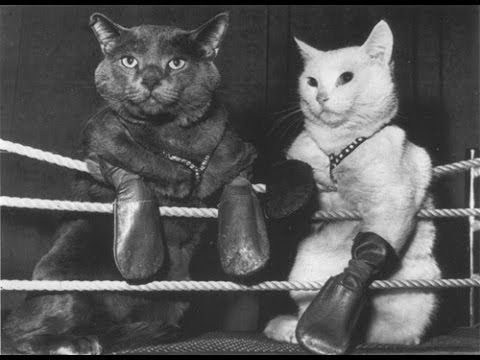
The climax of every Swain’s Rats and Cats show was a boxing match between two cats. (These are not Swain’s cats)
A few years ago I wrote about Tommy Casanova Lamb, the mascot cat of The Lambs club in New York City. Tommy often got into boxing matches with other male cats that tried to encroach on his territory, which is why some of the younger members of The Lambs would say (tongue in cheek) that Tommy was a descendant of one of the performing cats in Charles Swain’s Rats and Cats vaudeville act.
The act, which was billed as a comedy novelty, featured felines and rodents working in harmony to perform all sorts of aerial stunts and circus acts, like walking and jumping over blocks, jumping from high places, and tightrope walking. The most memorable part of the show was when the rats, dressed as jockeys, rode on cats wearing saddles in a steeplechase race along a miniature racetrack. Every show ended with a “comedy skit” featuring two cats boxing each other. (One newspaper called the boxing scene “one of the most laughable things ever presented upon any stage.”)
Charles Swain was born Charles Schwein in Cincinnati, Ohio, on June 4, 1867. According to newspaper ads from 1899, Swain began working with trained goats, dogs, monkeys, chickens, pigeons, geese, and ducks in an act called Farmer Swain’s Barnyard Circus or Swain’s Great Barnyard Circus. A year later, he was touring the country with the same animals as Professor Charles Swain’s Barnyard Circus. The rats and cats first appeared in 1910, in an act called Swain’s Rat and Cat Circus. (His wife, Cora, toured separately with an act called Swain’s Cockatoos.)
Here’s how Variety described the show in 1920: “One of the best animal acts in vaudeville and misses greatness by the man’s mild showmanship. The rats and cats fraternize like lodge brothers and execute a difficult routine of wire walking and jumping and balancing stunts. One of the feature tricks is a cat stepping over seven hurdles on top of each one a rat is reclining.”
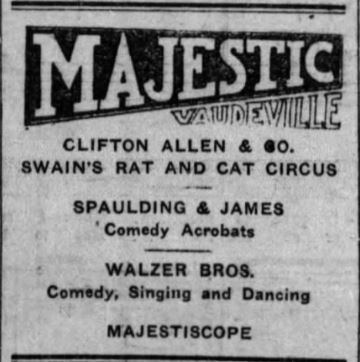
Swain’s rats and cats made their first appearance in Sioux Falls, South Dakota, as Swain’s Rat and Cat Circus. (Even from the beginning, the rats took top billing.)
Swain’s rats and cats were fondly recalled by many major twentieth-century vaudeville stars, including George Burns, Groucho Marx, Fred Allen, Joe Laurie, Jr., and Paul “Mousie” Garner (of course). George Burns joked about it in 1976, recalling his own days in vaudeville by saying, “I was so bad, once I was on the bill, and the headliner was Swain’s Cats and Rats.” Joe Laurie, a member of The Lambs, noted in his memoirs that the cats were fed right before each show while the poor rats were kept semi-starved and docile.
Several stars told the story in which Fanny Brice retired to find a rat in her dressing room. She screamed for Swain, who entered, looked at the rat, and said “That’s not one of mine!”
According to Groucho Marx, however, the “self-made rat” appeared at the Palace in New York the following week and won every race. According to Groucho, the dirty old rat had become the star of the act.
Shah the Cat Saves a Rat at Madison Square Garden
In April 1916, Swain took his rats and cats act to New York City, where they performed for large crowds at Madison Square Garden, then located on Madison Avenue at 26th Street, at the northeast corner of Madison Square Park. (Boxing has a long history at Madison Square Garden, so the venue was perfect for the pugilist cats.) Also on the bill for the matinee shows was Mary and her “intelligent dogs.”

Madison Square Garden II (1890-1926) was designed by noted architect Stanford White, who kept an apartment there. The 32-story tower was the city’s second tallest building at the time it was constructed. The main hall was the largest in the world, with seating for 8,000 people and floor seating for thousands more.
I’m not sure whose bright idea this was, but for some reason the rats, cats, and dogs were all grouped quite close together back stage in the “pad room” while they waited for their turns to perform for the children in the audience. The rats were in a wicker basket on the floor next to a stand upon which “the trained cats nodded as lazily as though they were before an open grate in a New England farmhouse.”
One of the rats squealed, which attracted the attention of Peggy, one of Mary’s terriers (perhaps it was a rat terrier?). The little dog tiptoed over to the rat basket, and next thing you know, he tried to snatch one of Swain’s valuable and intelligent rats in his jaws.
Swain grasped his whip to drive the dog away, but the rat “had a defender that was much more agile than the offender.” It was Shah, a large Persian cat, “who had been taught to like rats other than in the usual feline way.”
The instant Peggy was about to close in on the rat, Shah leaped on top of the dog and dug her claws into his back. Peggy let out a shriek and went running to Mary. For a moment it appeared as if all hell would break lose – none of Mary’s dogs were fond of cats – but Mary and Swain were able to come to the rescue and break up the fight before things got out of hand.
“I almost wish that the incident had taken place in the circus, so the people generally could see that by proper training even affection can be instilled into such born enemies as rats and cats,” Swain told the New York Herald. “When the Shah was a kitten I had a great difficult in keeping him from eating the mice and rats with which I was teaching him to perform. However, by the exercise of patience he overcame his appetite, and the incident in the pad room shows how fond he is of his fellow performers, the rats.”
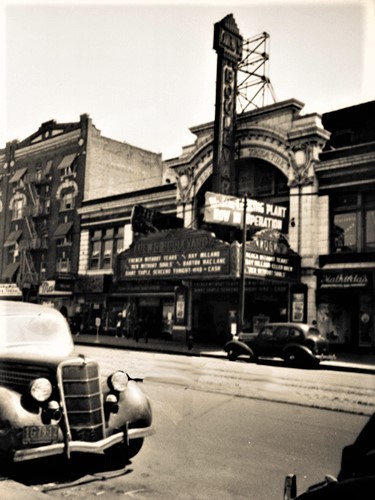
The Loew’s Boulevard Theatre in the Foxhurst section of the Bronx opened in 1913, three years before Swain’s rats and cats took the stage there.
The Rats and Cats Receive a Bronx Cheer
In March 1917, Swain brought his rodents and felines to Loew’s Boulevard Theatre on Southern Boulevard in the Foxhurst section of the Bronx. Although I’m sure many people in the audience enjoyed the performance, the act didn’t get a great review in the New York Clipper the next day:
“While Swain’s Rats and Cats are very clever, it is questionable whether this kind of an act is suitable for a vaudeville audience. To many the sight of rats is repellent. As a proof of this contention, when one of the rats started to run front of the stage and it appeared as if he was about to get into the audience, many of the women screamed in fright.”
The Loew’s Boulevard Theatre
Loew’s Boulevard Theatre at 1032 Southern Boulevard was constructed on the former estate of Christian V. Spencer. Nearby to the northeast was the estate of George Fox (1624-1691), the founder of the Society of Friends (commonly known as the Quakers) who preached in this section of the Bronx in the 1670s.
The theater opened as a vaudeville house on November 1, 1913, just three years before Swain’s rats and cats took the stage. Designed by Thomas W. Lamb, one of the preeminent theatre and cinema architects of the early 20th century, the Beaux Arts style theater had 2,187 seats and presented a mix of vaudeville and films.
The Boulevard was one of several Bronx theaters that Marcus Loew purchased from David Picker (Picker started with a nickelodeon in the Bronx and turned it into a chain of theaters that eventually merged with Loew’s Theaters.) In addition to the Boulevard, other Picker-built theaters in the Bronx acquired by Loew were the Spooner and Burland, as well as the Oriental in Brooklyn.
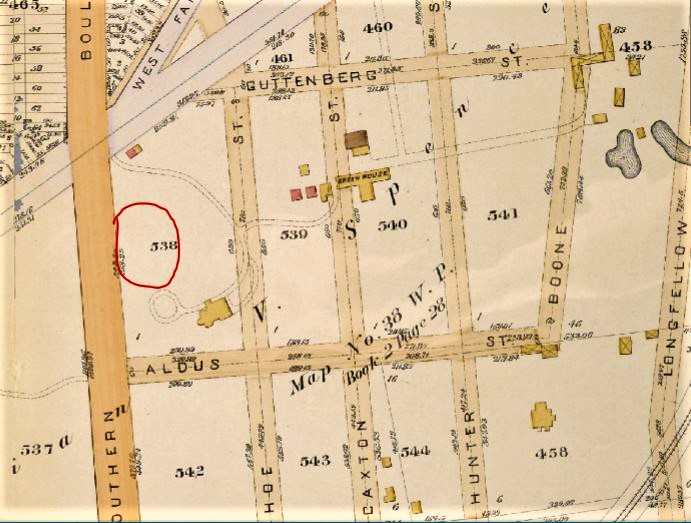
The red circle marks the location of the Boulevard Theatre on this 1887 map. The large frame house with the circular drive may have been the estate of Richard M. Hoe, which was called Britghtside (demolished in 1909). There is also a large greenhouse on this property, near the center of the map on what was called Caxton Street.
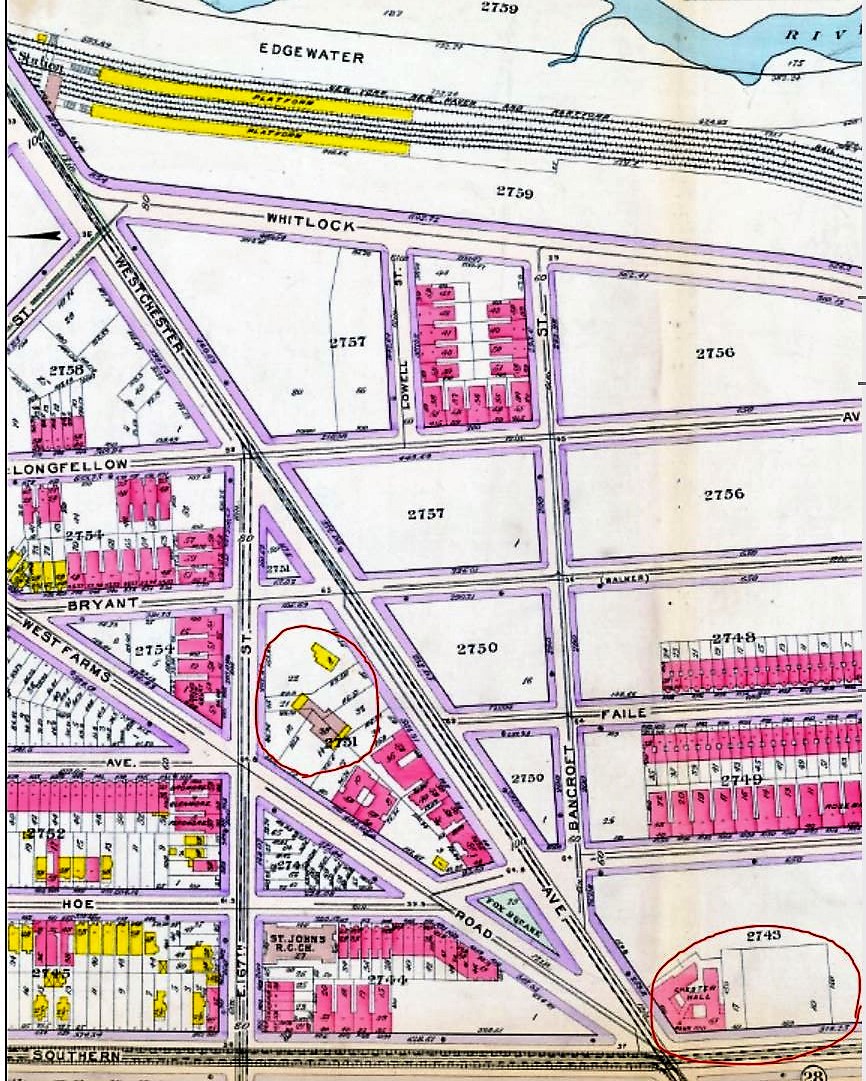
Loew’s Boulevard Theatre was constructed in 1912-13 on what had been an empty lot near the six-story Chester Hall apartments (extent), the first elevator structure put up in the vicinity Fox Square (circled in red on the bottom right of this 1911 map). The Foxhurst section of the Bronx was named for the Fox family and the “Foxhurst” mansion, located between West Farms Road and Westchester Avenue (circled in red in the center).
Part of the Loew’s chain until 1964, the Boulevard Theatre was later operated by an independent operator and screened Spanish language films. The theater closed in 1980, and today houses a gym and cell phone store. Incidentally, one of the last presentations at the theater was a closed-circuit viewing of the boxing match between Sugar Ray Leonard and Robert Duran on November 25, 1980.

The Boulevard Theatre now houses a gym and retail stores.
Stay tuned for my next post, which will go into more details about the Foxhurst section of the Bronx, the old Fox family mansion, and the fox hunts that took place in this area between the British and the Americans during colonial times.



